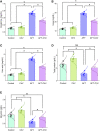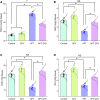Microalgae (Chlorella vulgaris) attenuates aflatoxin-associated renal injury
- PMID: 38205372
- PMCID: PMC10777483
- DOI: 10.3389/fphar.2023.1291965
Microalgae (Chlorella vulgaris) attenuates aflatoxin-associated renal injury
Abstract
Introduction: Aflatoxins (AFT) are ubiquitous environmental pollutants that are extremely dangerous for both human beings as well as animals. A safe, effective, and considerate strategy is therefore credited with controlling AFT intoxication. Therefore, our study aimed to evaluate the mitigating properties of Chlorella vulgaris (ChV) against AFT-induced nephrotoxicity and altered egg quality. Methods: Quails were randomized into Control group (receiving a normal diet); ChV group (1 g/kg diet); AFT group (receiving an AFT-containing diet); and the AFT-ChV group were given both treatments. Results and discussion: AFT provoked kidney injury, exhibited by increased renal biochemical parameters and reduced protein levels. Malondialdehyde (MDA) levels dramatically increased as a consequence of AFT exposure, and glutathione (GSH) levels, superoxide dismutase (SOD), and glutathione peroxidase (GPx) activities were also decreased. Substantial up-modulation of the mRNA expression of the inflammatory cytokines (TNF-α, IL-1β, and IL-6) was additionally reported. Furthermore, AFT residues were detected in the egg compromising its quality and nutritional value. Contrarily, ChV supplemented diet suppressed the AFT-prompted oxidative stress and inflammation, together with enhancing the nutritional value and quality of eggs and decreasing AFT residues. These beneficial impacts are proposed to be attributed to its antioxidant and nutritional ingredients. The molecular docking dynamics confirmed the inflammatory and apoptotic protein targets for ChV. Our findings recommend that adding ChV supplements to foods might guard against nephrotoxicity brought on by AFT exposure.
Keywords: Japanese quail; apoptosis; computational modeling; inflammatory cytokines; oxidative stress; residues.
Copyright © 2023 Abdeen, Elsabagh, Elbasuni, Said, Abdelkader, El-Far, Ibrahim, Mihaela, Fericean, Abdelfattah, El-Hewaity, Elbarbary, Kadah and Ibrahim.
Conflict of interest statement
The authors declare that the research was conducted in the absence of any commercial or financial relationships that could be construed as a potential conflict of interest.
Figures








Similar articles
-
The Preferential Therapeutic Potential of Chlorella vulgaris against Aflatoxin-Induced Hepatic Injury in Quail.Toxins (Basel). 2022 Dec 1;14(12):843. doi: 10.3390/toxins14120843. Toxins (Basel). 2022. PMID: 36548739 Free PMC article.
-
Dietary Chlorella vulgaris effectively alleviates oxidative stress, immunosuppression, and enhances the resistance to Streptococcus agalactiae infection in cadmium-intoxicated Nile tilapia fingerlings.Fish Shellfish Immunol. 2023 May;136:108717. doi: 10.1016/j.fsi.2023.108717. Epub 2023 Mar 31. Fish Shellfish Immunol. 2023. PMID: 37004894
-
The effect of dietary Chlorella vulgaris inclusion on goat's milk chemical composition, fatty acids profile and enzymes activities related to oxidation.J Anim Physiol Anim Nutr (Berl). 2018 Feb;102(1):142-151. doi: 10.1111/jpn.12671. Epub 2017 Apr 26. J Anim Physiol Anim Nutr (Berl). 2018. PMID: 28447361
-
Ameliorative effect of herbacetin against cyclophosphamide-induced nephrotoxicity in rats via attenuation of oxidative stress, inflammation, apoptosis and mitochondrial dysfunction.Hum Exp Toxicol. 2022 Jan-Dec;41:9603271221132140. doi: 10.1177/09603271221132140. Hum Exp Toxicol. 2022. PMID: 36198566
-
Chlorella vulgaris supplementation effects on performances, oxidative stress and antioxidant genes expression in liver and ovaries of New Zealand White rabbits.Heliyon. 2019 Sep 14;5(9):e02470. doi: 10.1016/j.heliyon.2019.e02470. eCollection 2019 Sep. Heliyon. 2019. PMID: 31687566 Free PMC article.
Cited by
-
Alchemilla vulgaris modulates isoproterenol-induced cardiotoxicity: interplay of oxidative stress, inflammation, autophagy, and apoptosis.Front Pharmacol. 2024 Aug 7;15:1394557. doi: 10.3389/fphar.2024.1394557. eCollection 2024. Front Pharmacol. 2024. PMID: 39170697 Free PMC article.
-
Unraveling the Potential of Saccharum officinarum and Chlorella vulgaris towards 5-Fluorouracil-Induced Nephrotoxicity in Rats.Pharmaceuticals (Basel). 2024 Jul 4;17(7):885. doi: 10.3390/ph17070885. Pharmaceuticals (Basel). 2024. PMID: 39065736 Free PMC article.
References
-
- Abdeen A., Abdelkader A., Elgazzar D., Aboubakr M., Abdulah O. A., Shoghy K., et al. (2020). Coenzyme Q10 supplementation mitigates piroxicam-induced oxidative injury and apoptotic pathways in the stomach, liver, and kidney. Biomed. Pharmacother. 130, 110627. 10.1016/j.biopha.2020.110627 - DOI - PMC - PubMed
-
- Abdel-Daim M., Dawood M. A. O., AlKahtane A. A., Abdeen A., Abdel-Latif H. M. R., Senousy H. H., et al. (2020). Spirulina platensis mediated the biochemical indices and antioxidative function of Nile tilapia (Oreochromis niloticus) intoxicated with aflatoxin B1. Toxicon 184, 152–157. 10.1016/j.toxicon.2020.06.001 - DOI - PubMed
-
- Abdel-Daim M. M., Abdeen A., Jalouli M., Abdelkader A., Megahed A., Alkahtane A., et al. (2021). Fucoidan supplementation modulates hepato-renal oxidative stress and DNA damage induced by aflatoxin B1 intoxication in rats. Sci. Total Environ. 768, 144781. 10.1016/j.scitotenv.2020.144781 - DOI - PubMed
LinkOut - more resources
Full Text Sources

